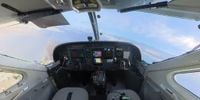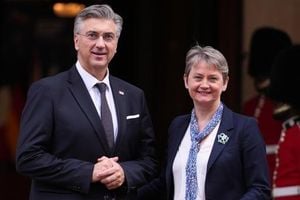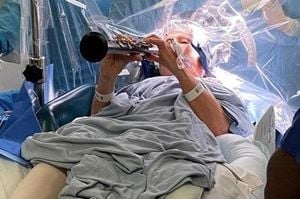At a nondescript office in Mountain View, California, a whiteboard bears a simple, bold declaration: "Aircraft should fly themselves!" For the engineers and technicians at Reliable Robotics, this isn’t just a catchy slogan—it’s a mission statement. On October 10, 2025, the company took another step toward that vision, as two staff members watched a Cessna Caravan navigate the skies above northern California. The plane, about 40 miles away, was flying itself. There was a pilot and a flight-test engineer on board, but only as a precaution. The real pilot, if you will, was the plane’s own suite of sensors and algorithms, quietly making decisions in real time.
Reliable Robotics is among a group of ambitious startups aiming to revolutionize aviation by removing the need for human pilots—not just for cargo or military flights, but eventually, perhaps, for passenger planes as well. The company’s recent $17 million contract with the U.S. Air Force is a testament to how seriously this vision is being taken, at least for now, in the cargo and military sectors. According to Dow Jones & Company, Reliable Robotics’ focus on autonomous cargo flights is already being put to the test, with the Air Force looking to leverage these advances for its own logistical operations.
But Reliable isn’t alone in this high-flying race. Flying-taxi maker Joby Aviation recently tested its own pilotless Cessna for the Air Force over the Pacific Ocean, as reported by Dow Jones & Company. Even aviation giants Boeing and Airbus are exploring the possibilities of increased automation, although both companies currently maintain that their commercial jet designs will continue to include pilots in the cockpit. The aim, as they put it, is to enhance safety, not replace human judgment entirely—at least, not yet.
Over the past few decades, advances in cockpit technology have already trimmed the number of people required to safely operate commercial aircraft. Where once there might have been a navigator and a flight engineer alongside the pilots, today’s jets typically require just two pilots. Automation has played a crucial role in this transformation, with modern planes capable of flying and even landing themselves under normal conditions. Still, pilots remain essential, programming inputs, monitoring systems, and standing by to intervene if anything goes awry.
The Air Line Pilots Association, a major union representing U.S. and Canadian aviators, is adamant that safety depends on having two well-trained, well-rested pilots in the cockpit—ready to handle emergencies and provide the human touch that automation simply can’t replicate. As Jason Ambrosi, the union’s president, put it, "It’s a robot flying a Cessna Caravan in the desert remotely. It’s a lot different than an A350 or a 777 leaving out of JFK over to Europe." That skepticism is echoed by many in the industry, who see a long road ahead before fully autonomous passenger flights become a reality.
Airbus, for its part, has been working on a project called extended minimum crew operations, or eMCO. The idea is to reduce the number of pilots required in the cockpit during certain phases of flight—particularly on long-haul journeys—by building in smart automation features. For example, if a plane depressurizes, the system would automatically descend to a safe altitude, alert air-traffic control, and avoid other aircraft on the way down. According to Airbus chief commercial test pilot Malcolm Ridley, "It’s going to support the crews, not replace them." The European plane maker has already implemented some of these features on its A350, a wide-body jet used for international flights.
Despite these advances, regulators remain cautious. The European Union Aviation Safety Agency continues to require at least two pilots in commercial cockpits, citing a recent study that couldn’t demonstrate the eMCO system was as safe as the current standard. "Any consideration of this will depend on the new technologies first proving their safety benefit," a spokeswoman for the agency told The Wall Street Journal.
Boeing’s approach has evolved in the wake of tragedy. After two fatal crashes involving the 737 MAX—where a flawed flight-control system overpowered pilots—Boeing shifted its focus toward developing automation that doesn’t rely on pilots responding perfectly in an emergency. The company’s Wisk autonomous electric air taxi, currently being tested with ground controllers instead of pilots on board, serves as a proving ground for these new technologies. Still, Boeing executives emphasize that their commercial jetliners will continue to have two pilots in the cockpit for the foreseeable future. As Jim Webb, Boeing’s chief commercial pilot, said at a recent pilot union conference, "These types of technologies are going to be an incredible enhancement."
Eric Allison, chief product officer at Joby Aviation, believes the novelty of autonomous flight will eventually wear off, much like driverless taxis or household robots have become more familiar. "The way these technologies are getting woven in is certainly going to make it much more mundane to interact with, effectively, robots on a regular basis—whether they are robot cars or [robots for home chores] or robot airplanes," he told The Wall Street Journal.
Reliable Robotics, meanwhile, is pressing ahead. CEO Robert Rose, who previously worked on autonomous technologies at SpaceX and Tesla, says the company’s new autopilot system will likely start with "safety pilots" behind the controls, paving the way for further regulatory approvals. The ultimate goal is to win Federal Aviation Administration certification for fully remote pilots by 2028. The FAA, for its part, set out a pathway for certifying remotely piloted and autonomous aircraft back in 2020, but declined to comment on Reliable’s specific efforts.
To make their vision a reality, Reliable is developing an onboard radar system that will allow its autopilot to "see" and avoid other aircraft—a crucial step, since current collision-avoidance systems rely mostly on transponders and sensors, not radar. The company is also working on stronger actuators to replace the muscle power of human pilots, ensuring planes can be controlled even in situations where manual intervention would normally be required.
Reliable’s ambitions don’t stop at technology. Rose says the company plans to deploy its certified autonomous system in and around populated areas, starting with Albuquerque, New Mexico. "We’re talking about a certified system that is certified for use in and around populated areas," Rose told The Wall Street Journal. "We do anticipate many of the lessons learned there to transfer to other operations around the country and much of the world."
As the debate continues, one thing is clear: the skies are on the cusp of a transformation. Whether passengers will be comfortable boarding a plane without a human pilot remains to be seen, but the groundwork is being laid, one autonomous flight at a time.




